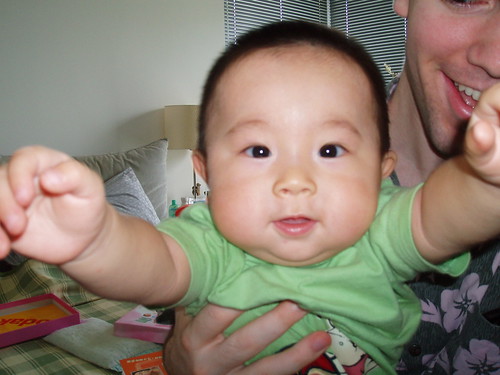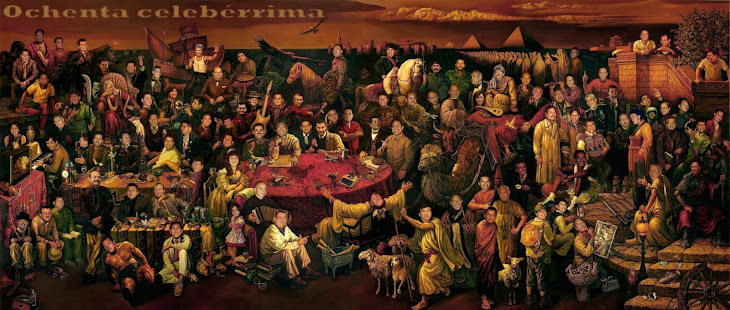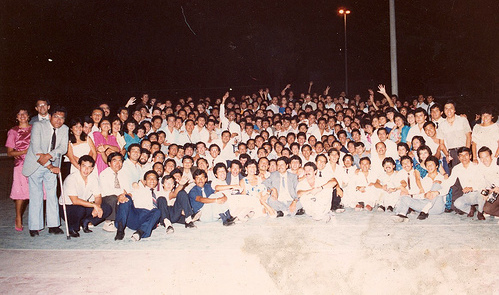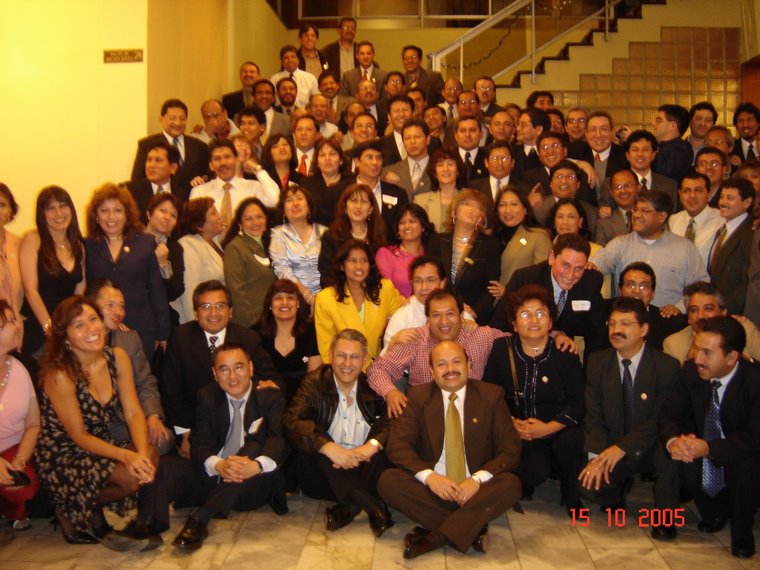CHIFA al estilo GASTON: MADAM TUSAN
desde el 19 de abril del 2011
(112 platos a la carta)
CHIFA (en chino cantonés)
“chi” = COMER
“faan" = ARROZ
Hay 5000 chifas en una ciudad de 9 millones...
Madan Tusan : Inversion : 1'200,000 dolares
http://www.youtube.com/watch?v=P4ZwUis1210
Gaston Acurio's Chinese food in Peru
http://www.livinginperu.com/
By Jorge Riveros-Cayo
Madam Tusan is the latest culinary adventure of iconic Peruvian chef Gastón Acurio. Opened a month ago, this new eatery challenges your senses with an offer of 112 dishes that fusions Chinese tradition with Peruvian ingredients. Chifa, the result of such a mix, is loved by Peruvians as much as a good ceviche. LivinginPeru.com made a unique tour of Madam Tusan's kitchen, and made a visual register of how it works. And more importantly, how good it tastes.
A huge, winding, serpent-like, red dragon flies in and out of dark, squared windows over the heads of hungry and anxious diners sitting in the main hall of the restaurant. They want to eat it all. Who could blame them? But the dragon looks down on them with a fearsome look, as if questioning their reproachable but understandably gluttony.
However, unlike European dragons which have always been considered destructive and malevolent in legends and folk stories, their Chinese counterparts are a symbol of power, strength and good luck. Dragons are the bearers of auspicious powers. In Chinese daily life, outstanding people are compared to these creatures.
Limeños, seized by a predictable curiosity and justified expectation, wondered for months what Gastón Acurio had in mind with his most recent culinary adventure: Madam Tusan, a Peruvian-Chinese restaurant, or simply a “chifa.” The word can be traced back to Canton (or Guandong) – one of the richest regions situated in the southern coast of the People’s Republic of China – where it probably originated from the words “chi” and “faan," meaning “eat” and “rice.” Chifa is also the name given to the fusion of Chinese cuisine with Peruvian ingredients, as popular as any of Peru's emblematic dishes, such as a freshly made ceviche or a creamy and spicy ají de gallina.
I raise my head to zoom in at the giant acrylic-made red dragon – built by a talented sculptor named Marcelo Wong, I learned later – that overlooks the restaurant’s main hall. It has funny, almost floating whiskers. Suddenly a waiter passes by, swiftly, but stops abruptly when he notices I am mesmerized by the flying creature. He looks at me and then raises his eyesight to the dragon. Then he comes closer and whispers as if he would reveal to me the ultimate culinary secret of the world, maybe reading my mind, “that dragon is Gastón Acurio.” I think about it for a minute. Strength and good luck. Bearer of auspicious powers. It does makes sense.
“It is a joint-venture,” Pepe Cárpena tells me, the general manager of this new food temple with oriental taste. Acurio contributed with the know-how, as usual, and this time a fast-food company was the financial investor. Delosi, acronym for San Ignacio de Loyola, is the country’s largest international fast-food franchise operator that runs a handful of U.S. franchises in Peru, including KFC, Burger King, Pizza Hut, Pink Berry and Chili’s Grill & Bar. They decided to become the operating business partner of Grupo Acurio in Madam Tusan, with an initial investment of around $1.2 million. This is their first experience with a Peruvian franchise.
“Delosi will develop the brand in Peru and Grupo Acurio will do so abroad. As a matter of fact, the site of Madam Tusan in Santiago, Chile is being built as we talk,” says Cárpena, a very close friend of Acurio who was in charge of La Mar Cebichería since its beginning before taking over this new culinary-business challenge. There are also talks to open Madam Tusan in Colombia and Mexico, says Pepe, with the same business partners that started La Mar in Bogotá and Astrid & Gastón in the Mexican capital. But, where did this frenzy for Chinese food and culture started?
A little bit of history
The first 75 Chinese to reach Peru’s coasts in 1849 escaped social and political unrest that took over their native country: China’s defeat in the Opium Wars against the British Empire and the surging of the Tai Ping religious movement, supported by farmers fighting for an independent state free of foreign abuse, cornered Beijing. As a result, thousands of Chineses started a long exodus through the following years to the Americas, mainly to the western coast of the United States, the island of Cuba, but also Panama and Peru.
During the following 25 years, more than a hundred thousand Chinese workers known as “coolies,” arrived to work in Peru’s guano islands and coastal haciendas. After Ramón Castilla abolished slavery in 1854, the Chinese started to replace the black population work force that had been confined to the haciendas since the Colonial period. They contributed largely to the improvement of the sugar cane and cotton industry, but worked in deplorable conditions for decades. Almost as if they were slaves themselves.
A last wave of coolie migration arrived Peru in 1874. After the War of the Pacific against Chile, Chinese population started to move into urban areas of Peru's coastal strip, becoming more involved in business, opening stores, warehouses, and restaurants of course. In Lima, the Chinese community clustered around the old, historical neighborhood of Barrios Altos, nearby downtown Lima, giving birth to the Barrio Chino or Lima’s Chinatown around the 1950’s. Twenty years later an arch was built donated by Taiwan’s nationalist leader Chiang Kai-shek.
Today, there are no less than five thousand chifas spread among a city of nine million people such as Lima. Chifa can be considered a fast-food menu lunch as well as a solemn and gregarious social event at one of the capital’s top-end restaurants such as Wa Lok, Royal and now Madam Tusan. Chifa is the ultimate expression of generosity and abundance, which is impossible to enjoy plentifully if you plan to go on your own or somebody else. I’ll rephrase myself: The best way to enjoy a good chifa experience is to go with a group of friends. If they are incorrigible foodies, even better. So that is exactly what I did.
An imperial banquet
Peruvians hardly drink alcohol with chifa, since we are more prone to gulp down liters of the bubble-gum flavored Inka Cola with a good arroz chaufa, instead of a beer. Traditions they call it.
But after going over the cocktail list, my friends and I were curious to try, for example, a colorful Chinita Sexy (quebranta pisco, strawberry juice, mint and lime), or a more exotic Drágon Loco (quebranta pisco, orange and passion fruite juice, and black mint). If you do not like them that sweet go for a Pepe Tam (quebranta pisco, vermouth, fernet, passion fruit and cranberry juice), or the more tangy Miss Capon (vodka and a mix of prickly pear, tangerine and passion fruit juice). If you pass on alcohol, give a try to the fruit juice mixes such as Chilimoyita (custard apple, strawberry and tangerine), or a Frutao (passion fruit, pineapple and lychee), among other options. Simply delicious.
For nibbles and appetizers we were suggested the following: Plan Chao, grilled mini-empanadas stuffed with pork, shrimp and veggies, and the fusion-like Butifarra China which is a Min Pau sandwich filled in with tender slices of roasted pork, spiced with pickled onions and rocoto hoisin. A must. Our favorite however was the Encamotao, a delicate bonbon-like entrée filled with shrimp and chicken, and wrapped in shreaded crusty sweet potato that is dipped in an orange juice sauce.
We were far from attending Manchu Han's Imperial Feast, but believe me when I say that ordering at madam Tusan can be quite a task. There are exactly 112 dishes listed on the menu, and this is when team work is highly valued. Most of us agreed in making an adventurous ordering combined with some classic Chinese dishes. From Madam Tusan's specialty list, we tried Pollo Madam Tusan, probably the tenderest steamed chicken I have ever had in my life, smothered with a ginger sauce, green onions and sesame oil. We also tried the less subtle Plancha de mariscos al tausí, grilled shrimp, squid and scallops with tausi sauce, incredibly delicious and rich. One more: Lechoncito horneado en caja china, tender piglet roasted in a China box (think of a microwave for the masses), served with Min Pau, sugar and soy sauce.
When it comes to more classic dishes, personally I am not that crazy for the roasted pork with garlic because it tends to be very dry and not as pleasant to munch on as it sounds. However, you should try Chancho al ajo con nabo, a generous dish of juicy, garlicky roasted slices of pork served with pickled turnip. Excellent. An emblematic dish of the house, as we were told, is the Tallarín saltado de Félix con frijolito chino, fried noodles made Félix-style – none other than the main chef of the restaurant – served with cowpea beans. Finally, we added a sweet-sour twist to the already generous order of food with Medio pato a la laguna con duraznos, half roasted duck in a peach sauce. Good stuff. And surprisingly not extremely sweet.
No Chinese meal can be complete without a generous portion of steamed rice. But in Peru we are highly fond of arroz chaufa, fried rice, to accompany our chifa orders which has evolved to a more massive, local fast-food presentation known as “aeropuerto,” with bits of fried noodles and cowpea beans. Don’t ask me where the name comes from – I have no clue –but Acurio had to reinvent the popular dish and now serves Chaufa aeropuerto at Madam Tusan with different kinds of toppings: from sauté veggies, chicken or mushrooms, to pork and shrimp. A great side dish to combined with the more rich-flavored orders above.
Since no meal can be called such without a good dessert (okay, this is totally arbitrary), I encouraged some of my friends to order with me a Copón de Lychee: A huge martini glass served with iced orange in the bottom, lychee sorbet in the middle, and topped with fluffy pisco sour foam. Frankly revealing and more importantly, refreshing after such a pantagruelic feast! At this point in time (three hours later) it was time to leave but not before figuring out one more thing.
Who is Madam Tusan?
Liliana Com is a living legend of the Chinese community in Peru. Born to Chinese immigrants from Canton, in the heart of Barrios Altos, a few blocks away from Lima’s Chinatown, Liliana is the service manager of Madam Tusan. I like to think of her more as the natural-born host of this eatery. And this is because she knows everybody around and everything it takes to make you feel comfortably at home. This is not a cliché. Chinese hospitality is world known and Liliana is not the exception when it comes to generosity.
“In my family we were raised with the notion that eating was not only an act of pleasure but, more importantly, an act of building a healthy life,” she says. Around 37 years ago, she managed Siu Lam, a family restaurant that was quite successful.
In the early nineties, a Chinese immigrant named Alan Chang arrived to Peru and decided to open a chifa in Chinatown, something unthinkable when the surroundings literally where taken by street vendors and pickpockets. But it also was the time when Lima’s major Alberto Andrade was trying very hard to recover the historic area of downtown. And he succeeded.
Wa Lok was opened and people started going back to Chinatown to eat at this fabulous place. Who was the host and manager? None other than Liliana. “Chinese have always thought Peru is a blessed land; there is everything you need food-wise to make a Chinese happy. I think that is one of the main reasons why so many decided to move here,” she says.
Even if she is reluctant to admit it, Liliana is the image of Madam Tusan. As a matter of fact, she is Madam Tusan, as I see it: A name derived from the term “tusan” that is used to described second generation Chinese. Madam Tusan at the end, is another succesful culinary project of Gastón Acurio, who has once again hit it right.
Madam Tusan:
Av. Santa Cruz 859, Miraflores
Lima, Peru
(half a block away from Óvalo Gutierrez)
Reservations (strongly suggested) at 505-5090 or via email: madamtusan01@franquiciasperu.com
Sun to Thu: 12 p.m. to 1 a.m.
Fri to Sat: 12 p.m. to 2 a.m.
All major crecit cards accepted
viernes, mayo 20, 2011
Suscribirse a:
Comentarios de la entrada (Atom)














No hay comentarios.:
Publicar un comentario